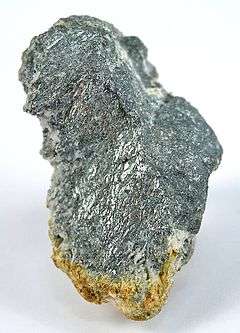Stützite
| Stützite | |
|---|---|
|
Stützite from the Moctezuma Mine, Sonora, Mexico (size:3.7 x 3.3 x 1.7 cm) | |
| General | |
| Category | Telluride mineral |
| Formula (repeating unit) | Ag5−xTe3 (with x = 0.24 to 0.36) |
| Strunz classification | 2.BA.30e |
| Crystal system | Hexagonal |
| Crystal class |
Dihexagonal dipyramidal (6/mmm) H-M symbol: (6/m 2/m 2/m) |
| Space group | P6/mmm |
| Unit cell | a = 13.38, c = 8.45 [Å]; Z = 7 |
| Identification | |
| Color | Dark lead-gray |
| Crystal habit | Massive, compact, granular |
| Cleavage | None observed |
| Fracture | Subconchoidal |
| Tenacity | Brittle |
| Mohs scale hardness | 3.5 |
| Luster | Metallic |
| Diaphaneity | Opaque |
| Specific gravity | 8.0 |
| Alters to | Tarnishes rapidly to a dark bronze to iridescence |
| Other characteristics | Anisotrpism in polished section: Moderate, in gray reddish brown-blue |
| References | [1][2][3] |
Stützite or stuetzite is a silver telluride mineral with formula: Ag5−xTe3 (with x = 0.24 to 0.36)[1] or Ag7Te4.[4]
It was first described in 1951 from a museum specimen from Sacarimb, Romania. It was named for Austrian mineralogist Xavier Stütz (1747–1806).[1][2]
It occurs with other sulfide and telluride minerals in hydrothermal ore occurrences. Associated minerals include sylvanite, hessite, altaite, petzite, empressite, native tellurium, native gold, galena, sphalerite, colusite, tennantite and pyrite.[1]
References
This article is issued from Wikipedia - version of the 11/29/2016. The text is available under the Creative Commons Attribution/Share Alike but additional terms may apply for the media files.
